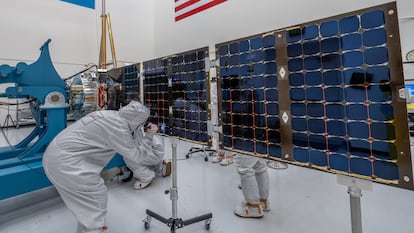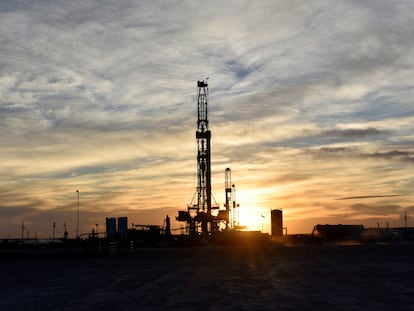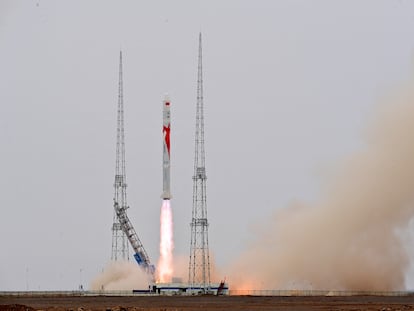The ‘Big Brother’ that will monitor oil industry methane leaks is orbiting Earth already
An NGO has raised $88 million to launch a satellite that will report on emissions of this powerful greenhouse gas


The fight against methane, the gas responsible for around 25% of the global warming recorded on the planet since the pre-industrial era — has been at the center of the international climate agenda in recent years. And starting this week, it has an ally that will be decisive. MethaneSat is the first non-commercial satellite put into orbit that is designed specifically to detect methane leaks. The project has been developed by Environmental Defense Fund (EDF), the American NGO which managed to forge an alliance between activists and scientists six years ago to launch a monitoring satellite. An investment of around $88 million has been required, which EDF has raised from the New Zealand government and various foundations, such as the Bezos Earth Fund. The satellite was launched Monday night and is expected to be operational this summer.
“When we think about climate change, our mind goes to carbon dioxide,” explains the leader of EDF’s methane science team, Daniel Zavala. “But there are other gases such as methane that are much more powerful in their warming effect in the first few decades after being emitted. We want to make this invisible problem visible,” Zavala says.
The fact that this gas is invisible to the human eye contributes to large leaks (intentional or accidental) linked to oil, gas, and coal extraction going unnoticed and unpunished. The MethaneSat project wants to fight against this. The satellite “will map 80% of global oil and gas production,” says Zavala. There are 25 regions on the planet where the main methane deposits are found. Data from these will be monitored daily and made available to anyone who is interested in consulting the readings. Moreover, this project will also contribute feeding data to the alert network for major leaks that was created under the umbrella of the U.N. environmental protection program.
The so-called International Methane Emissions Observatory (IMEO) was created in 2021 and currently has a large leak warning system that also uses data from satellites owned by public space agencies, but which were not specifically designed to monitor the gas, as is the case with MethaneSat. “It is very exciting that, for the first time anywhere in the world, an NGO is launching a satellite designed to monitor methane in the oil and gas sector,” says Manfredi Caltagirone, director of the IMEO, underlining the key contribution that this project will make to the observatory and the alert network. Caltagirone adds: “Transparency is changing the rules of the game in this battle to control methane emissions.”
Physicist Luis Guanter leads a group of researchers from the Polytechnic University of Valencia (UPV) that specializes in identifying large methane leaks. He also collaborates with EDF. The scientist explains that at the moment there are other satellites with ability to detect megaleaks. But there is no non-profit organization that has been specifically designed to look for this gas and will also offer the data openly. Furthermore, another of the features that make it unique is that it is able to detect both “specific and diffuse leaks.”
Specific leaks are large leaks that normally occur in oil and gas exploitation and that leave a trail in the form of a plume that can be detected through satellites. Diffuse discharges are numerous, smaller discharges, such as those generated by rice paddies, landfills, and livestock farms, says Guanter. The new satellite can analyze grids of 40,000 square kilometers in search of these diffuse leaks.

Although the main purpose of MethaneSat is to monitor oil and gas infrastructure, it will also have an element that monitors emissions generated by agriculture, raising livestock, and rice production. This area of research will be led by a group of New Zealand scientists, who highlight that this is the “first satellite” that is able to “quantify diffuse agricultural emissions, due to its high level of precision and spatial resolution.” A study by the International Energy Agency (IEA) estimated a few years ago that 40% of global methane emissions come from natural sources, mainly wetlands. The remaining 60% is linked to human activities. Almost 25% comes from livestock and agriculture, 21% is due to fossil fuels, and another almost 12% is caused by waste.
However, when it comes to pinpointing the main culprits, it is not quite clear who is responsible for those emissions. Zavala explains that in the energy sector it is known that “about 100 million tons of methane are emitted per year.” “But we don’t have a clear idea of who is responsible,” the expert says. Thanks to this new satellite, it will be possible to trace the methane footprint of the fuels imported by the European Union or a particular state. It is a traceability that the EU’s institutions are interested in learning about in order to take legislative measures. “When you know where emissions occur, you know where to act,” says Zavala.
Caltagirone emphasizes that one of the essential weapons in the fight against climate change is data. “It is necessary that there be direct, credible, and transparent information so that companies, governments, NGOs, and the media can act,” he says.
One of the most important projects that IMEO has underway is the large leak warning network, which will benefit greatly from the new satellite. Itziar Irakulis-Loitxate, a researcher also at the UPV and one of the collaborators in the alert network, explains that this is “the first system in the world to detect large emissions and alert governments and companies.” At the moment, it is focused on oil and gas exploitation, but coal fields, which are also a major source of leaks, will soon be added. Since January 2023, the team at IMEO has notified governments and companies of 187 emissions.
Sign up for our weekly newsletter to get more English-language news coverage from EL PAÍS USA Edition
Tu suscripción se está usando en otro dispositivo
¿Quieres añadir otro usuario a tu suscripción?
Si continúas leyendo en este dispositivo, no se podrá leer en el otro.
FlechaTu suscripción se está usando en otro dispositivo y solo puedes acceder a EL PAÍS desde un dispositivo a la vez.
Si quieres compartir tu cuenta, cambia tu suscripción a la modalidad Premium, así podrás añadir otro usuario. Cada uno accederá con su propia cuenta de email, lo que os permitirá personalizar vuestra experiencia en EL PAÍS.
¿Tienes una suscripción de empresa? Accede aquí para contratar más cuentas.
En el caso de no saber quién está usando tu cuenta, te recomendamos cambiar tu contraseña aquí.
Si decides continuar compartiendo tu cuenta, este mensaje se mostrará en tu dispositivo y en el de la otra persona que está usando tu cuenta de forma indefinida, afectando a tu experiencia de lectura. Puedes consultar aquí los términos y condiciones de la suscripción digital.
More information
Archived In
Últimas noticias
Welcome to the post-religion era: The idea of Christianity as the absolute truth has become obsolete
‘I thought you would like it’: The risky sexual practice popularized by TV shows and TikTok
The digitalization of tourism: ‘They promise experiences and gave us the worst possible one’
Mexican peso defies uncertainty with forecasts of a new period of stability in 2026
Most viewed
- Sinaloa Cartel war is taking its toll on Los Chapitos
- Reinhard Genzel, Nobel laureate in physics: ‘One-minute videos will never give you the truth’
- Oona Chaplin: ‘I told James Cameron that I was living in a treehouse and starting a permaculture project with a friend’
- Why the price of coffee has skyrocketed: from Brazilian plantations to specialty coffee houses
- Silver prices are going crazy: This is what’s fueling the rally










































